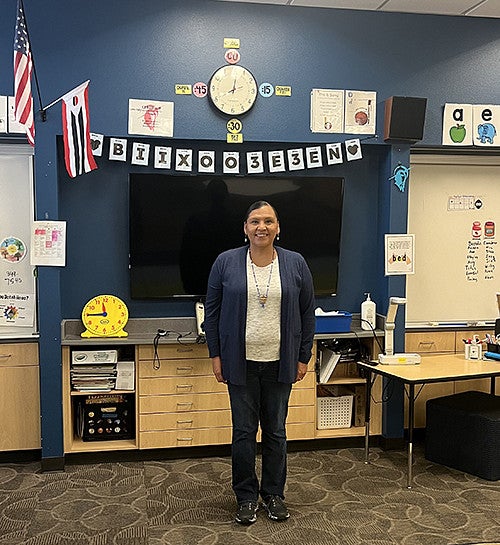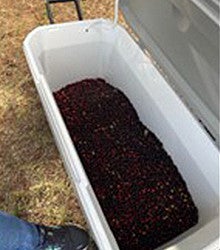
Learn more about Taralee Suppah (Ahshamnasho), Sapsik'ʷałá alumni, through our Alumni Spotlight series
"Being from the Warm Springs Reservation, it has always been instilled in me to remember where I come from and who I am." – Taralee Suppah (Ahshamnasho)
Meet Taralee Suppah (Ahshamnasho), a 2007 graduate of University of Oregon’s Sapsik'ʷałá Teacher Education program. Taralee Is a member of the Confederated Tribes of Warm Springs of Oregon and has known from a young age that she wanted to become a teacher.
During her time in the program, Taralee attended Saturday workshops that consisted of hands-on activities that worked to equip students with activities they could implement in their own classrooms. She credits the program for supporting students to take pride in their Indigenous identity and communities and encourage students in their own classrooms to do the same.
Following graduation, Taralee had the opportunity to teach on the reservation where she received her education for 10 years. She is now a first-grade teacher on the Wind River Indian Reservation in Wyoming. The skills she learned at UO have helped her share language and culture in her daily lessons, support students’ sense of identity, and create a classroom environment where they feel like they belong.
Tribe: Confederated Tribes of Warm Springs (OR)
Why did you choose to pursue the Sapsik'ʷałá program and a career in education?
When I finished my bachelor’s degree at Fort Lewis College, I was hired as a paraprofessional in the schools and this helped me grow professionally. After two years, I knew I was ready to teach, however at the time, teachers were being encouraged to be “highly qualified” and that meant having a master’s degree. I learned of the Sapsik'ʷałá program, and I submitted my application.
I have known since a young age that I wanted to become a teacher. First, it was because I wanted to coach basketball, and later during my college summer, I worked for our Culture & Heritage department at home. I was able to attend the Linguistics program over the summer at the University of Oregon. From this experience, I wanted to find a way to implement culture and language into my classroom. Now, I have been teaching for 15 years.

Describe your career path since completing the Sapsik'ʷałá program:
I began teaching right after graduating from the University of Oregon. I was able to work in my reservation (Confederated Tribes of Warm Springs Reservation of Oregon) and the place where I received my elementary education-Warm Spring Elementary, later turned to Warm Springs K-8 Academy. I taught there for 10 years. I now teach and live on the Wind River Indian Reservation (WY) and teach at Wyoming Indian Elementary School. I have taught here for four years.

What did you learn in the program that you have found most valuable in teaching?
During my time at the University of Oregon, I was able to attend Saturday workshops that the program provided. The workshops consisted of hands-on activities that we got to participate in, but it was also a model of how we could implement activities like this into our own classroom.
Being from the Warm Springs Reservation, it has always been instilled in me to remember where I come from and who I am. I think this is the most important thing I have learned, and I believe the program supports this by providing such an amazing opportunity to be educated at the University of Oregon.
Today, I am a teacher at Wyoming Indian Elementary School in a first-grade classroom. The things I learned at the University of Oregon have helped to support me and my co-teacher (Dual Language teacher and speaker of the Arapaho language) to implement language and culture into our daily lessons.
Living and working at a school district that supports our students, teachers, and community to learn to speak the language has been awesome. We have monthly cultural activities for our students to help support the students having a proud and positive identity. It is also important to create a classroom environment where students feel like they belong, and we provide this by speaking the language and creating an indigenized classroom.
How has Indigenous Elder mentorship shaped your learning within the university and in relational practices in your own life-and as a teacher?
I have not been a part of the Elder mentorship at the University. However, I have a Dual-Language teacher in my classroom every day. She is an elder in our community and is teaching our students the language. My son is 6 years old and is in year two of being in the Dual language program. We are his teachers this school year. She brings knowledge of the culture and language into our daily lessons. I help support her by sharing my knowledge of writing lesson plans, classroom management, engagement strategies and teaching strategies. Within the process, I am currently learning to speak the Arapaho language and am learning the culture at school and in the community.
Having an elder and speaker of the language in our classroom everyday reminds me of the importance of keeping the language and culture alive for many generations to come.
*Artwork featured on the left is an image created by our cultural director of our school district. Picture on the right is from Chokecherry picking with our students.
